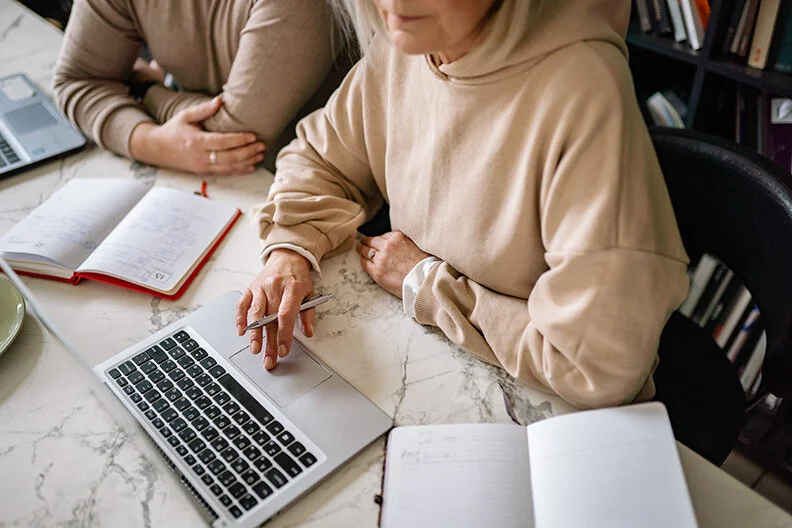In this post I want to discuss how to invite difficult stories into the oral history space. We are, all of us, walking around with the weight of some history on our shoulders; in addition to our own, we carry the weight of our ancestors’ burdens deep in our cells. Bringing up ancestral stories may trigger trauma responses, in either you as the oral historian, or the interviewee. But telling stories of resilience, or how our ancestors survived, can create positive change in ourselves and future generations.
Resmaa Menakem, a somatic practitioner and psychotherapist specializing in trauma, talks at length about trauma responses and how to heal them in My Grandmother’s Hands. Trauma is embedded in our body, in our physical responses. It may look like someone shutting down when asked a question, saying, “I don’t want to talk about that.” Certain strategies, like fleeing from an uncomfortable conversation, can be passed down and repeated over generations. According to Menakem, overreactions, such as lashing out disproportionately to a seemingly innocuous conversation, “can be the body’s attempt to complete a protective action that is thwarted or overridden during a traumatic situation.”
I’ve talked with family historians who attempted to have conversations with their parents about their war experiences, specifically as young Filipino victims of World War II. The parents are reluctant to talk about that time, or they talk about it with a stone face, naming events and places without going into any embodied detail. These historians are surprised, because to them the stories are so shocking. I believe these are their parents’ trauma responses: the parents, as young people, were unable to do anything about the circumstance they were in when it came to war atrocities. It was protective for them to stay quiet and follow (as opposed to fight or flee) in that situation. So that’s how they remain.
As oral history interviewers, it is our responsibility to proceed ethically. How do you hold and witness the story? How do you bring the interviewee out of it?
Menakem says, “When mending trauma we need to proceed slowly so we can uncover the body’s functions without triggering another trauma response.”
How to create a safe space for talking about trauma
I believe that as an oral historian, it’s not my job to be a therapist or to force someone to talk. It’s my job to create a space and a silence in which the person may be willing to talk. A few practices I recommend:
Be an active listener.
Be present and aware. Have your list of questions and your research as a guide. But above all, during the interview, give the interviewee the chance to tell their story. Don’t fact-check or interrupt in the moment.
Consider the whole self.
Your interviewee is not defined by that one traumatic event in their past, or the burden of their ancestors. Start your interviews from before the event, and continue the story after.
Consider the history around the traumatic event.
What environment and outside forces led to your interview subject’s circumstance? Do some research to understand the local, global, and political forces that intersect with your interviewee’s world.
Breathe.
If you are feeling a trauma response, or you can sense that your interviewee is having one, take a pause. Breathe together. Turn off the audio recorder. Feel what’s tight in your body and invite your interviewee to do the same.
If talking about this topic is too difficult or painful, invite your interviewee to free-write through it. Be ready with pen and paper. Turn off the audio recorder. Tell them to write without stopping, not to worry about grammar or perfection, just write whatever’s going through their head. Set a timer. Sit as a witness to their writing, or leave the room if that’s more comfortable for them. When the timer finishes, come back together. Don’t ask the interviewee to share what they’ve written (if they want to share, of course they may).
Be ready with more neutral questions.
At the end of any interview, make sure you bring the interviewee out of the difficult space. Ask neutral questions, or forward-looking questions.
Acknowledge their resilience.
No matter how heavily the trauma weighs on the interviewee, they’re here. Acknowledge gratitude and the circumstance that brought you together, here, at this time in history.
I hope these strategies help you invite in the difficult stories. Menakem writes about traumatic retention, “when a [traumatic] strategy gets internalized and passed down over generations within a particular group it can start to look like culture.” While therapeutic healing is not the oral historian’s goal, being sensitive and aware of the trauma that oral history can bring up may help the interviewee create space to deal with and heal from the weight of the past. And in doing so, they (and you) may interrupt the trauma so future generations can approach their history and present in a more positive way.
______________________________
Amanda Lacson, founder of NYC–based FamilyArchive Business, helps people tackle their family archive at any stage, from organizing photos in boxes to creating final products to share with family.







